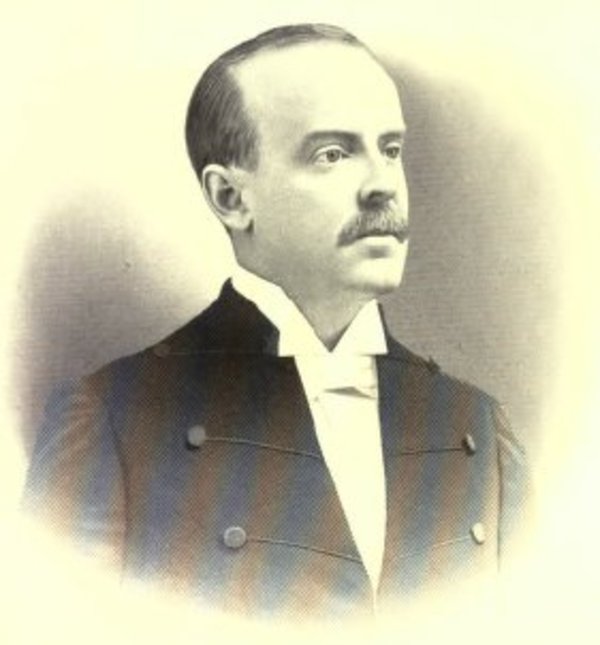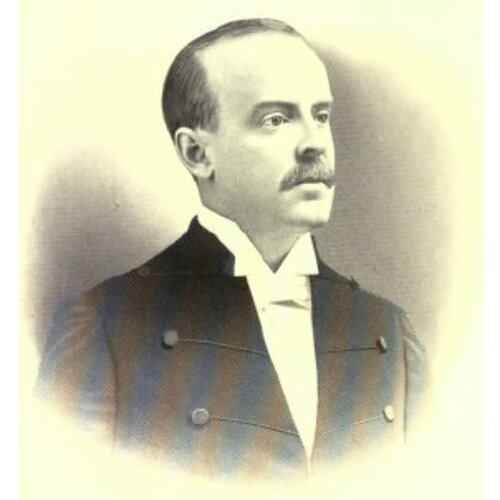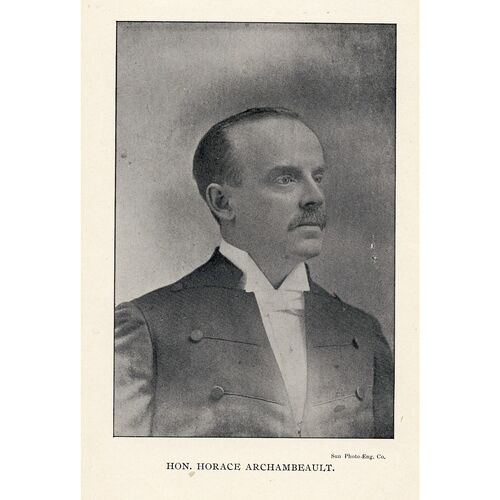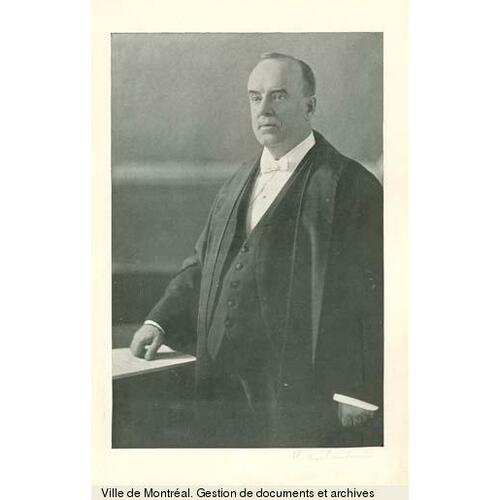
Source: Courtesy of Wikimedia Commons
ARCHAMBEAULT, Sir HORACE (baptized François-Xavier-Horace), lawyer, professor, politician, office holder, and judge; b. 6 March 1857 in L’Assomption, Lower Canada, son of Louis Archambeault* and Marguerite-Élisabeth Dugal; m. 27 Sept. 1882 Élizabeth Lelièvre at Quebec; they had no children; d. 25 Aug. 1918 in Trois-Pistoles, Que., and was buried 28 August in Notre-Dame-des-Neiges cemetery, Montreal.
Horace Archambeault did classical studies at the Collège de L’Assomption from 1867 to 1875 and completed them at the Petit Séminaire de Québec. He then enrolled at the Université Laval, where he obtained a degree in law in 1878. He was called to the bar that year and, moving immediately to Montreal, began a career as a lawyer.
Archambeault first went into partnership with the lawyer Louis-Henri Archambeault and later formed a firm with Henri-Benjamin Rainville and Honoré Gervais. He seems to have enjoyed a good reputation, although he did not achieve the prominence some of his colleagues attained. He held a number of professional offices. After serving on the council of the Montreal bar from 1890 to 1898, he became its vice-president. He was bâtonnier of the Montreal bar and of the Quebec provincial bar in 1900–1.
In 1881, while still a young practitioner, Archambeault had become professor of commercial law and maritime law at the Montreal campus of the Université Laval. The teaching of law at that time was entrusted only to veteran jurists and the appointment of a neophyte was highly unusual. In 1886 he received his doctorate. Like most of his Quebec and Montreal colleagues, he was awarded it by virtue of being a professor and did not have to write or defend a thesis. In 1915 he succeeded Michel Mathieu as dean of the faculty of law, a position he held until his death. While he was dean, the university offered a program of studies in commercial law for the Association des Femmes d’Affaires de Montréal. During the same period, the Montreal university, which was still under the control of Laval, was anxious to obtain its independence. To achieve this goal, the vice-rector and auxiliary bishop of Montreal, Georges Gauthier, had to persuade each of the faculties, which were separately incorporated. He began his offensive by attempting to win over Archambeault and his teaching staff. Once the initial reserve had been broken down, the faculty of law declared itself in favour of union. The others would follow suit later. The process thus set in motion would in the end, after complicated negotiations, lead to independence for the Montreal campus in 1920.
When in June 1888 Archambeault’s father had resigned from the Legislative Council as representative for the division of Repentigny, his son was invited to take his seat. Archambeault was seen as a National Conservative, but eventually became a Liberal. During his 20 years on the council he took an active part in its debates and he became speaker in 1897. Appointed attorney general by Premier Félix-Gabriel Marchand* that year, he held the same office in the government of Simon-Napoléon Parent. He had been regarded by some as a possible successor to Parent, but he was easily pushed aside by Lomer Gouin* when Parent was forced to resign in 1905. Faithful to Parent until the end, he was not included in the new cabinet.
Archambeault’s responsibilities as attorney general were mainly connected with the administration of justice. He distinguished himself as a reformer when a bill on industrial accidents was introduced in 1904. Under the civil law then in force, a worker who sought compensation for a work-related accident had to prove that the employer had been negligent. However, as manufacturing had evolved, industrial accidents had radically changed. It was often impossible to prove negligence on the part of anyone at all, if indeed there had been negligence. Under Archambeault’s bill, which was modelled on French legislation, industrial accidents would be subject to a special statutory regime. The employer would now be responsible, as head of the enterprise, for accidents involving his workers even in the absence of any negligence on his part. This reform would not become law, however, until late in the decade.
In 1906 Archambeault refused appointment to the Supreme Court of Canada to replace Henri-Elzéar Taschereau, but two years later he agreed to become a judge in the Quebec Court of King’s Bench. In 1911 he was made chief justice of that court and thus of the province, succeeding Sir Louis-Amable Jetté.
The many judgements handed down by Archambeault during his decade on the bench reveal the main lines of his legal thinking. In general, he respected the division of powers among the different branches of the state. In his view, the legislative and judicial branches had been acknowledged to have specific responsibilities and neither was to infringe on those of the other. His judgements showed little variation in style. He strove constantly for synthesis. He gave a precise description of the facts underlying the case and outlined clearly the questions of law to be considered. His reasoning, like that of other judges of his time, tended to be formalistic, that is, favouring an exegetical approach to texts. Unlike some contemporary jurists who based their arguments on numerous citations from decisions and theoretical works, he limited his references to the essential, and made every effort to prevent common law from encroaching on civil law.
Rigorous logic, however, did not stop Archambeault from taking equity and justice into account. Even though, like his colleagues, he held to the tenets of economic liberalism, he did his best to give a broad and generous interpretation of the statute on industrial accidents, which had come into effect in 1909. He showed much less flexibility in 1915 when ruling on Annie Macdonald* Langstaff’s petition for a court order requiring the bar to allow her to study for the legal profession. On that occasion he kept to the letter of the law, finding it impossible for women to have access to legal practice unless the legislature intervened.
Appointed a qc by the governor general in 1889, Archambeault was knighted in 1915. On two occasions while he was chief justice, he was called on to act for the lieutenant governor as administrator of the province.
A man of modest ambitions, Sir Horace Archambeault remains a secondary figure. Despite his fine qualities and his record of service, he could not hope to become premier. On the other hand, he undertook a number of important academic and judicial responsibilities. By his actions, first as a legislator and then as a judge, he helped shape social law in Quebec.
Sir Horace Archambeault is the author of “De l’étude du droit romain,” in La Thémis (Montréal), 1 (1879–80): 150–60. He also published two of his speeches in the Legislative Council; the first, entitled Discours prononcé par l’hon. M. H. Archambeault le 10 juillet 1888 au Conseil législatif sur la question des biens des jésuites (Québec, 1888), was taken from the Débats of the council, and the second, delivered on 1 June 1904, was published in a pamphlet which reproduced the text of the Loi relative aux dommages résultant des accidents du travail (Québec, 1904).
AC, Montréal, État civil, Catholiques, Cimetière Notre-Dame-des-Neiges (Montréal), 28 août 1918. ANQ-M, CE5-14, 8 mars 1857. ANQ-Q, CE1-1, 27 sept. 1882. La Presse, 26 août 1918. F.-J. Audet, Les juges en chef de la province de Québec, 1764–1924 (Québec, 1927), 167–68. DPQ. J. Hamelin et al., La presse québécoise, 4: 8–9. Jean Hétu, Album souvenir, 1878–1978; centenaire de la faculté de droit de l’université de Montréal (Montréal, 1978). J.-J. Lefebvre, “Les Archambault au Conseil législatif; quelques précisions sur sir Horace, l’hon. Louis et l’hon. Pierre-Urgel Archambault,” BRH, 59 (1953): 23–28. Le Jeune, Dictionnaire. Edmond Orban, Le Conseil législatif de Québec, 1867–1967 (Paris et Montréal, 1967). Quebec Official Reports: King’s Bench (Quebec), 1908–18. G.-É. Rinfret, Histoire du Barreau de Montréal (Cowansville, Qué., 1989). P.-G. Roy, Les avocats de la région de Québec; Les juges de la prov. de Québec. Rumilly, Hist. de la prov. de Québec, vols.5–11. Gustave Turcotte, Le Conseil législatif de Québec, 1774–1933 (Beauceville, Qué., 1933).
Cite This Article
Sylvio Normand, “ARCHAMBEAULT, Sir HORACE (baptized François-Xavier-Horace),” in Dictionary of Canadian Biography, vol. 14, University of Toronto/Université Laval, 2003–, accessed April 17, 2025, https://www.biographi.ca/en/bio/archambeault_horace_14E.html.
The citation above shows the format for footnotes and endnotes according to the Chicago manual of style (16th edition). Information to be used in other citation formats:
| Permalink: | https://www.biographi.ca/en/bio/archambeault_horace_14E.html |
| Author of Article: | Sylvio Normand |
| Title of Article: | ARCHAMBEAULT, Sir HORACE (baptized François-Xavier-Horace) |
| Publication Name: | Dictionary of Canadian Biography, vol. 14 |
| Publisher: | University of Toronto/Université Laval |
| Year of revision: | 1998 |
| Access Date: | April 17, 2025 |





